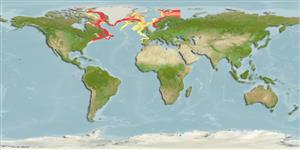Environment: milieu / climate zone / depth range / distribution range
Ecología
marino batidemersal; rango de profundidad 165 - 1342 m (Ref. 58426), usually 165 - 215 m (Ref. 42091). Deep-water; 79°N - 38°N, 76°W - 36°E
North Atlantic: English Channel, North Sea, Norwegian coastline, Svalbard, southwestern Barents Sea, off Spitzbergen, Bear Island, the Faeroes and Iceland, southeastern coasts of Greenland. Western Atlantic: New Jersey, USA to Gulf of St. Lawrence, Canada and Greenland.
Tamaño / Peso / Age
Maturity: Lm ? range ? - ? cm
Max length : 30.0 cm SL macho / no sexado; (Ref. 35388); common length : 14.0 cm SL macho / no sexado; (Ref. 6696)
Short description
Morfología | Morfometría
Four bony knobs between and behind the eyes. Skin very rough. Body with 3-4 broad, dark vertical bands (Ref. 35388).
Benthic (Ref. 58426). Feeds on polychaetes, mysids, amphipods and pycnogonids. Spawns probably from June to July, ovarian eggs large and few (up to 220) (Ref. 6696). Female lays 200 eggs with a length of 4.5-5 mm (Ref. 35388).
Life cycle and mating behavior
Madurez | Reproducción | Puesta | Huevos | Fecundidad | Larva
Fedorov, V.V. and J.S. Nelson, 1986. Psychrolutidae. p. 1261-1264. In P.J.P. Whitehead, M.-L. Bauchot, J.-C. Hureau, J. Nielsen and E. Tortonese (eds.) Fishes of the North-eastern Atlantic and the Mediterranean. UNESCO, Paris. Vol 3. (Ref. 6696)
IUCN Red List Status (Ref. 130435)
Threat to humans
Harmless
Human uses
Pesquerías: sin interés
Más información
ReferenciasAcuiculturaPerfil de acuiculturaRazasGenéticaElectrophoresesheritabilidadEnfermedadesProcesamientoNutrientsMass conversion
Herramientas
Special reports
Download XML
Fuentes de Internet
Estimates based on models
Preferred temperature (Ref.
123201): 0.3 - 7.7, mean 2.6 °C (based on 243 cells).
Phylogenetic diversity index (Ref.
82804): PD
50 = 0.5039 [Uniqueness, from 0.5 = low to 2.0 = high].
Bayesian length-weight: a=0.00389 (0.00180 - 0.00842), b=3.12 (2.94 - 3.30), in cm total length, based on all LWR estimates for this body shape (Ref.
93245).
Nivel trófico (Ref.
69278): 4.1 ±0.2 se; based on diet studies.
Resiliencia (Ref.
120179): Bajo, población duplicada en un tiempo mínimo de 4.5-14 años (Fec = 66).
Fishing Vulnerability (Ref.
59153): Low to moderate vulnerability (27 of 100).
Nutrients (Ref.
124155): Calcium = 20.5 [5.0, 69.0] mg/100g; Iron = 0.431 [0.149, 1.080] mg/100g; Protein = 14.8 [12.5, 17.8] %; Omega3 = 0.349 [0.133, 0.959] g/100g; Selenium = 12.6 [4.4, 43.1] μg/100g; VitaminA = 16.5 [3.4, 78.4] μg/100g; Zinc = 0.423 [0.217, 0.837] mg/100g (wet weight);
